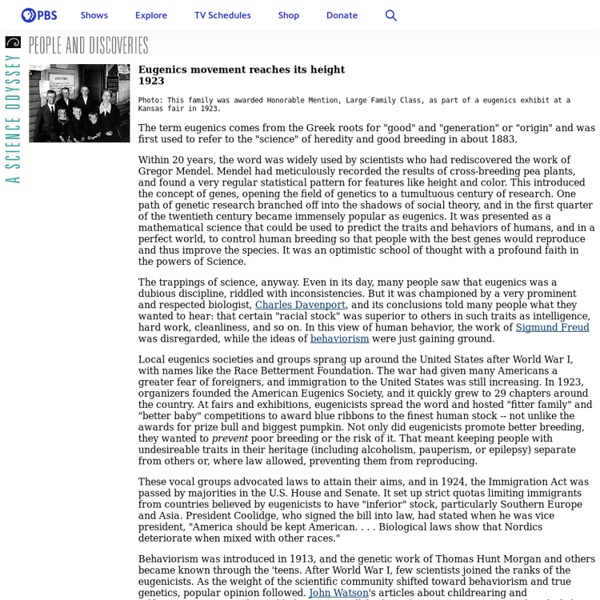Library : Introduction to Eugenics | Catholic Culture
by John Cavanaugh-O'Keefe Description This article summarizes a booklet from American Life League that gives the definition and history of the eugenics movement throughout the world, beginning with the idea of ethnic cleansing and continuing on to a discussion of selective genetics and population control as advocated by Planned Parenthood. Publisher & Date American Life League, 1995 The principal manifestations of eugenics are racism and abortion. Eugenics is the study of methods to improve the human race by controlling reproduction. A Study ... Galton defined eugenics as "the science of improvement of the human race germ plasm through better breeding." A Program ... The American Journal of Eugenics (1906) defined it as "the science of good generation" and noted that the Century Dictionary defined it (rather primly) as "the doctrine of Progress, or Evolution, especially in the human race, through improved conditions in the relations of the sexes." In 1970, I. A Religion ...
Eugenics debate
Eugenics
1. Short history of eugenics Although philosophers have contemplated the meaning and value of eugenics at least since Plato recommended a state-run program of mating intended to strengthen the guardian class in his Republic, the modern version of eugenics had its start with the 19th century cousin of Charles Darwin, British scientist Francis Galton (1883). Galton was interested in “improving human stock” through scientific management of mating; his explicit goal was to create better humans. His ideas were taken up widely in the early part of the 20th century by seemingly well-intended scientists and policy makers, particularly in the United States, Britain, and the Scandinavian countries. Eugenicists had two-fold aims: to encourage people of good health to reproduce together to create good births (what is known as “positive” eugenics), and to end certain diseases and disabilities by discouraging or preventing others from reproducing (what is known as “negative” eugenics). 2. 3.
10 Fundamental Pros and Cons of Eugenics | ConnectUS
Eugenics is the belief that selecting the mating partners and controlling the offspring improves the quality of human life. According to history, it dates back to Ancient Greece, but after its adaption by the Nazis, eugenics gained much criticism, scrutiny and disapproval. Some say that eugenics is all-negative because selection is always determined by who is in power, and that it violates every human being’s right to reproduction. Nevertheless, we will soon find out that eugenics does have its own benefits, and knowing the pros and cons of eugenics helps us understand it better. List of Pros of Eugenics 1. 2. 3. 4. 5. List of Cons of Eugenics 1. 2. 3. 4. 5. Eugenics does have some benefits, but as an infant technology, it is has risks and prone to costly mistakes at the expense of actual humans.
'Designer babies' debate should start, scientists say
Image copyright SPL Rapid progress in genetics is making "designer babies" more likely and society needs to be prepared, leading scientists have told the BBC. Dr Tony Perry, a pioneer in cloning, has announced precise DNA editing at the moment of conception in mice. He said huge advances in the past two years meant "designer babies" were no longer HG Wells territory. Other leading scientists and bioethicists argue it is time for a serious public debate on the issue. Designer babies - genetically modified for beauty, intelligence or to be free of disease - have long been a topic of science fiction. Dr Perry, who was part of the teams to clone the first mice and pigs, said the prospect was still fiction, but science was rapidly catching up to make elements of it possible. In the journal Scientific Reports, he details precisely editing the genome of mice at the point DNA from the sperm and egg come together. "It is approaching 100% efficiency already, it's a case of 'you shoot you score'." New era
CASTI CONNUBII
To the Venerable Brethren, Patriarchs, Primates, Archbishops, Bishops and other Local Ordinaries enjoying Peace and Communion with the Apostolic See. Venerable Brethren and Beloved Children, Health and Apostolic Benediction. How great is the dignity of chaste wedlock, Venerable Brethren, may be judged best from this that Christ Our Lord, Son of the Eternal Father, having assumed the nature of fallen man, not only, with His loving desire of compassing the redemption of our race, ordained it in an especial manner as the principle and foundation of domestic society and therefore of all human intercourse, but also raised it to the rank of a truly and great sacrament of the New Law, restored it to the original purity of its divine institution, and accordingly entrusted all its discipline and care to His spouse the Church. 2. 3. 4. 5. 6. 7. 8. 9. 10. 11. 12. 13. 14. 15. 16. 17. 18. 19. 20. 21. 22. 23. 24. 25. 26. 27. 28. 29. 30. 31. 32. 33. 34. 35. 36. 37. 38. 39. 40. 41. 42. 43. 44. 45. 46.



